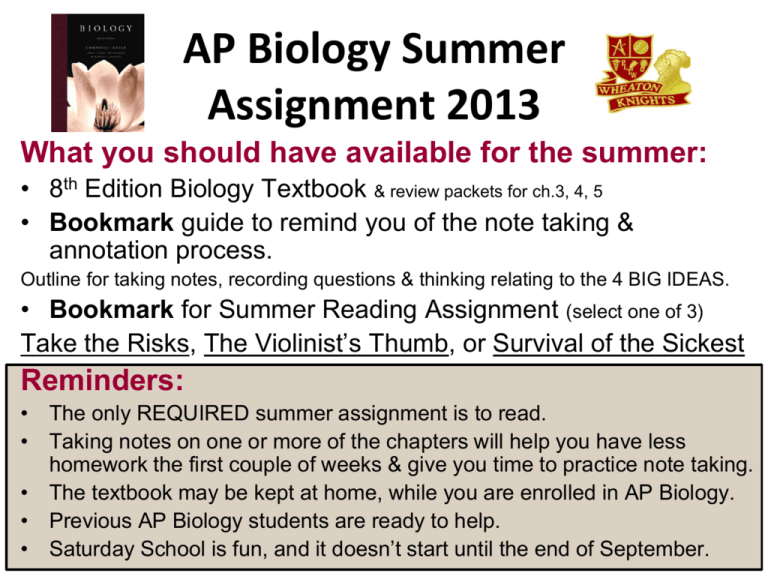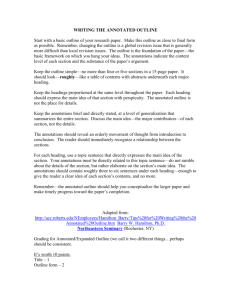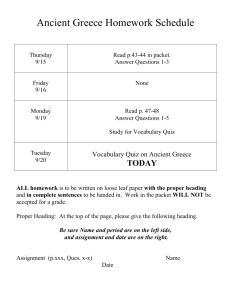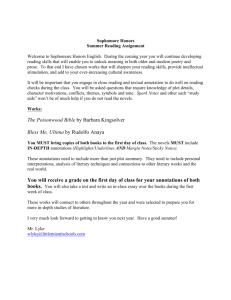How do I take outlined notes?
advertisement

AP Biology Summer Assignment 2013 What you should have available for the summer: • 8th Edition Biology Textbook & review packets for ch.3, 4, 5 • Bookmark guide to remind you of the note taking & annotation process. Outline for taking notes, recording questions & thinking relating to the 4 BIG IDEAS. • Bookmark for Summer Reading Assignment (select one of 3) Take the Risks, The Violinist’s Thumb, or Survival of the Sickest Reminders: • The only REQUIRED summer assignment is to read. • Taking notes on one or more of the chapters will help you have less homework the first couple of weeks & give you time to practice note taking. • The textbook may be kept at home, while you are enrolled in AP Biology. • Previous AP Biology students are ready to help. • Saturday School is fun, and it doesn’t start until the end of September. Notes Notes Notes Read ONLY the assigned “sections” of the review packet (see online weekly, for a reminder) Read ONLY the assigned “sections” of the review packet (see online weekly, for a reminder) Read ONLY the assigned “sections” of the review packet (see online weekly, for a reminder) Step 2 – Annotations Step 2 – Annotations Step 2 – Annotations Make annotations on review packet. (see Annotations on reverse) Make annotations on review packet. (see Annotations on reverse) Make annotations on review packet. (see Annotations on reverse) Step 3 – Skeleton notes Step 3 – Skeleton notes Step 3 – Skeleton notes In your OWN words In your OWN words In your OWN words Chapter # and Title Big idea Connection I. Major Heading –as a question Chapter # and Title Big idea Connection I. Major Heading –as a question Chapter # and Title Big idea Connection I. Major Heading –as a question (Purple text that corresponds to concept number i.e.- 6.1 is chapter 6, unit 1) a. Sub Heading (Blue text in the textbook; italics in the review packet) i. Major Details (include the bolded vocab) 1. Minor Details (clarify main ideas) (Purple text that corresponds to concept number i.e.- 6.1 is chapter 6, unit 1) a. Sub Heading (Blue text in the textbook; italics in the review packet) i. Major Details (include the bolded vocab) 1. Minor Details (clarify main ideas) (Purple text that corresponds to concept number i.e.- 6.1 is chapter 6, unit 1) a. Sub Heading (Blue text in the textbook; italics in the review packet) i. Major Details (include the bolded vocab) 1. Minor Details (clarify main ideas) Leave column for additions Drawings and Diagrams Step 1 – Review packets Leave column for additions Drawings and Diagrams Step 1 – Review packets Leave column for additions Drawings and Diagrams Step 1 – Review packets Step 4 – Class notes Step 4 – Class notes Step 4 – Class notes Add sketches & notes in the column during class Add sketches & notes in the column during class Add sketches & notes in the column during class Step 5 – Study and review Step 5 – Study and review Step 5 – Study and review Open the text, look at & draw diagrams, and READ the sections and add clarifying details to your notes. Look at the “root” words section of review packets and highlight them with in your notes. Go to web links on videos & animations, watch, & summarize processes. Buddy-up and explain it out loud. Open the text, look at & draw diagrams, and READ the sections and add clarifying details to your notes. Look at the “root” words section of review packets and highlight them with in your notes. Go to web links on videos & animations, watch, & summarize processes. Buddy-up and explain it out loud. Open the text, look at & draw diagrams, and READ the sections and add clarifying details to your notes. Look at the “root” words section of review packets and highlight them with in your notes. Go to web links on videos & animations, watch, & summarize processes. Buddy-up and explain it out loud. Annotations Annotations Annotations What? What? What? All printed text, that is YOUR property: review packets & journal articles. Tools? All printed text, that is YOUR property: review packets & journal articles. Tools? All printed text, that is YOUR property: review packets & journal articles. Tools? Pencil & Your Own Text: review packets & journal articles Pencil & Your Own Text: review packets & journal articles Pencil & Your Own Text: review packets & journal articles How? 1. First read with pencil in hand How? 1. First read with pencil in hand How? 1. First read with pencil in hand A pencil is better than a pen because you can make changes. While you read, use marginalia—marginal notes—to mark key material. Marginalia Important * interesting quotable “ questionable ? Flow charts, pneumonics, vocab., models A pencil is better than a pen because you can make changes. While you read, use marginalia—marginal notes—to mark key material. Marginalia Important * interesting quotable “ questionable ? Flow charts, pneumonics, vocab., models A pencil is better than a pen because you can make changes. While you read, use marginalia—marginal notes—to mark key material. Marginalia Important * interesting quotable “ questionable ? Flow charts, pneumonics, vocab., models 2. Then write, as the heading to your notes, a connection to at least ONE of the 4 BIG IDEAS: 2. Then write, as the heading to your notes, a connection to at least ONE of the 4 BIG IDEAS: 2. Then write, as the heading to your notes, a connection to at least ONE of the 4 BIG IDEAS: 1 - The process of evolution drives the diversity and unity of life. 2 - Biological systems utilize energy and molecular building blocks to grow, to reproduce, and to maintain homeostasis. 3 - Living systems store, retrieve, transmit, and respond to information essential to life processes. 4 - Biological systems interact, and these interactions possess complex properties. 1 - The process of evolution drives the diversity and unity of life. 2 - Biological systems utilize energy and molecular building blocks to grow, to reproduce, and to maintain homeostasis. 3 - Living systems store, retrieve, transmit, and respond to information essential to life processes. 4 - Biological systems interact, and these interactions possess complex properties. 1 - The process of evolution drives the diversity and unity of life. 2 - Biological systems utilize energy and molecular building blocks to grow, to reproduce, and to maintain homeostasis. 3 - Living systems store, retrieve, transmit, and respond to information essential to life processes. 4 - Biological systems interact, and these interactions possess complex properties. Add definitions or vocabulary you are uncertain of or questions you have about the reading. Add definitions or vocabulary you are uncertain of or questions you have about the reading. Add definitions or vocabulary you are uncertain of or questions you have about the reading. Survival of the Sickest How have diseases -caused by mutations of different genes in the human genome – that once helped humans to survive in their different environments become harmful to us? The Violinist’s Thumb How does DNA play a role in who we are physically How does it decide if we’ll have no fingertips, become cat ladies, or make us great violin players? Mrs. Sobieszczyk Ms. Cruz Take the Risks Is there such a thing as too much safety? What happens when we don’t take risks? Will separating conjoined twins allow them to move forward or will the risk be too deadly? Mrs. Carias







